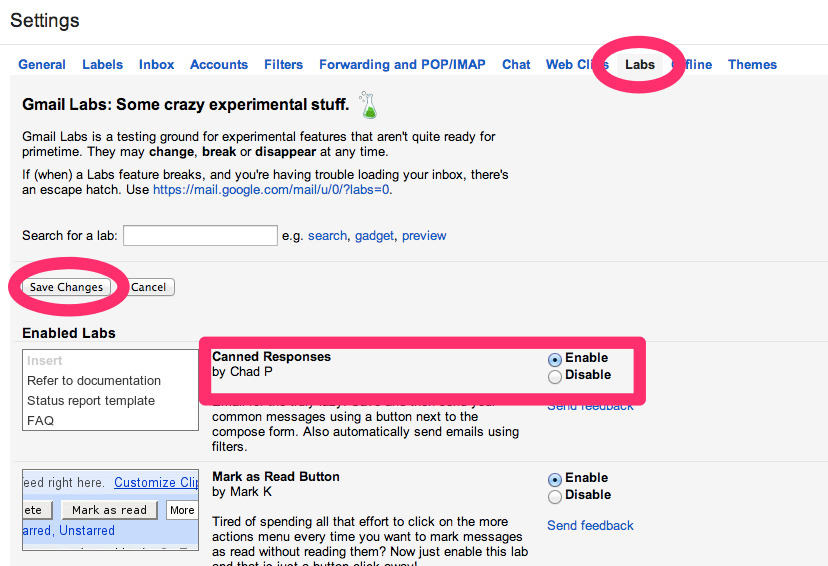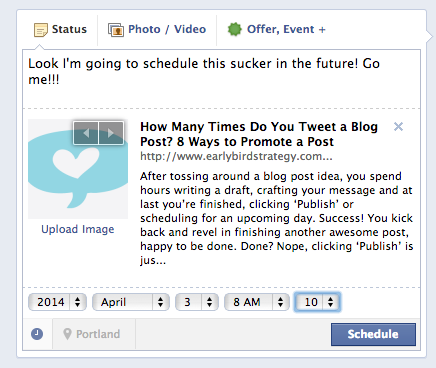SEO (search engine optimization) has a bad reputation these days. To non-technical folks it can seem confusing. And we often hear a lot of mixed messages about the dos and don’ts. SEO doesn’t have to feel impossible. By learning and applying little bits at a time, you’ll be doing your words a favor by letting more people find access to them! Here’s how to write SEO-friendly headlines and still sound like a human.
How SEO started, and what it’s all about at it’s most basic level, is helping people find you. Nothing shady in that, but where SEO gets it’s bad rap from is that you’re not the only one who wants attention for any given “key” word. As competition heats up, so do the shady tactics for getting attention. The kinda-shady bit is often what people refer to when they use the term SEO as dirty word.
So, should your #1 priority be to stick to creating value and writing amazing content that’s useful and helpful to people? Yes. But you’re doing yourself and all those awesome people you want to help a disservice if you ignore SEO altogether. So here is a 5 point checklist to review before you click that “Publish” or “Schedule” button on your blog post. Remember, this isn’t a required step every single time you blog. But if you’ve spent some time and really want to give a piece its best shot, give this process a try.
Blog Post Titles SEO:
Step 1. Pick some keywords. What is your post about?
If you had to pick two to three words to describe that 2,000 word epic draft that you just wrote, what would you say? What are the basic topics? When we have a few phrases and keywords to work from it’s easier to research keywords and pick a final title.
As an example, we’ll use a blog post that I wrote recapping my adventure into beginning running. I had written a draft blog post of things I’d learned. So I thought my blog post title could be something about things I’d learned or how to begin a running routine.
SEO Title Examples:
- How to Begin Running
- How to Start Running
- Things I Learned from Starting A Running Routine
- 43 Things I Learned from Running
Using a WordPress plugin like Yoast SEO, can also help you keep track of what “keyphrase” you’re targeting in your post. And then give you some tips for optimizing based on that.
Step 2. Keyword Research for SEO-friendly headlines
If you had a difficult time with Step 1, your next step should be to jump over to Google. Type in some of the words and phrases from Step 1. This gives us an idea of how to better phrase our keywords. Example:
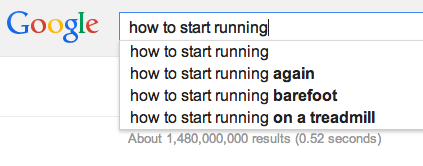
Now these results are not perfect, as it can be influenced on your past search data. And is also giving us phrases that start with what we’ve typed. Example, you don’t see “how to begin running” in that list. Otherwise, we can move on to the Keyword Research tool:
Google used to have a simple “Keyword Research” tool that they have since changed and moved into the AdWords platform. You don’t have to spend money in AdWords to use the tool. It’s just a bit more difficult to get to and not as user-friendly now. Here’s the tool and an explanation from Google. So put in a few of those title ideas and then click on the “Keyword ideas” tab. Then sort by “Avg. monthly searches”. You’ll also see some suggested keywords in the box below that, that might give you some additional ideas.
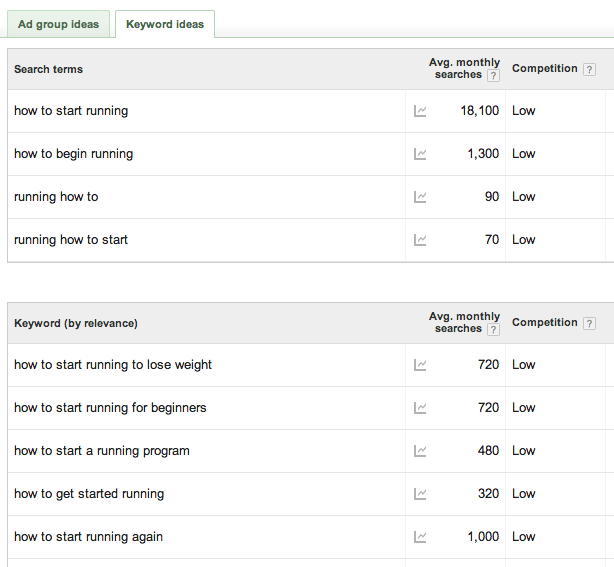
You’ll see that “how to start running” has a higher search volume. But since it’s higher, I might have a hard time getting traction on that term. So I’m going to shoot for “How to begin running” as the best bet for this post.
Remember, you need to pick something that’s relevant, not just something with high searches. So if it doesn’t match up with your content, don’t be silly and go for off topic.
Title: How to Begin Running
Permalink: not sure yet
Step 3. Select your Permalink URL slug.
The Permalink can also be called the slug url. It is simply the part of the link after your domain name. Example: poweredbytofu.com/how-to-start-running A Permalink will automatically appear in WordPress just below the title, when you’re editing a post. For url slug SEO, you’ll want to change it before publishing! Instead of letting it default to tons of words in the title, we’ll want to use some of the keywords we researched in Step 2. Keep it targeted, but short. Just click the Edit button and type in the title. It’s still best practice to separate words with a dash so search engines know what letters belong to what words.

Remember, you have the option to change your Title later, but you don’t ever want to change the actual url. Changing urls is a big no-no. It requires us to deal with messy things like redirects and stuff that can be a big hassle.
So based on the previous research, it sounds like how to begin running or how to start running would make a good slug url. Since I might change the title in the future, I’m going to have the slug url use the word “start”. Sometimes it makes sense to switch up the order of the words in the url. For example, sometimes we’ll find that the search volume is higher for a string more along the lines of “running how to start”. Which sounds rather yoda-ish and we wouldn’t want to title the post that, but we could put the permalink as that (eg. running-how-to-start) In this instance that’s not the case, so we can move to the next step.
Title: How to Begin Running
Permalink: how-to-start-running
Step 4. Be human. Be interesting. What’s your final headline?
Now that we have our seo-friendly title ready, we want to spruce it up to make it interesting to readers. We want to give our article the best shot at success. We didn’t write it for it to just look like an SEO play, and then not have anyone be interested. But at the same time we want to be interesting and relevant. If our readers don’t feel like the post they click through to read is indeed what we said it was going to be, we’re not building trust!
So just like I wouldn’t have titled the example post simply “Running”, I also wouldn’t title it something like “The Definitive Guide to Learning to Run” or “Everything you need to know to run your first half marathon”. For this post, it needs to be a bit more modest and a bit more personal. I’m not an expert on running. This is my personal take on things I learned. I want my headline to reflect that. So whether you go for a “how to” post, a numbered list post, ask a question, go for a controversial take, go the humorous or the “Best” route, just make sure your actual content can live up to your title claims. We want to “hook” our readers, but we don’t want to mislead them with our over-the-top seo-friendly headlines. It’s a fine line.
Jot down some ideas similar to what we did in Step 1. But that fit with your SEO-friendly headline intro. (in my example that’s the “How to Begin Running” intro). Examples: How to Begin Running – 43 Things I’ve Learned. Everything You Need to Know on How to Begin Running. How to Begin Running – My First 200 Miles. How to Begin Running: 43 Tips from My First 200 Miles. I like the last one best so that’s what I’ll continue with. It’s a little long, but my permalink is short. And I’m not trying (nor would I be able to) rank on google for the keyword of something like just “running” anyway.
Title: How to Begin Running: 43 Tips from My First 200 Miles
Permalink: how-to-start-running
Step 5. Bonus Points: Title Tags & Meta Descriptions
If you don’t want to get into the nitty gritty of WordPress plugins, you’re all ready to go with your new title. If you feel comfortable poking around in plugins, give the Yoast SEO plugin a try. It’s a powerful plugin though, so give the documentation a look before you enable it and start changing things!
Thanks to this plugin it can be quick and easy to change things like your title tags and meta description on a per-post basis from within our WordPress post editor. Title tags and meta description are what you would see when your content is displayed on Google:

Yoast even has a built-in tool that will remind you to make sure your target keywords are in the post: url, in-content, title tags, and meta description!
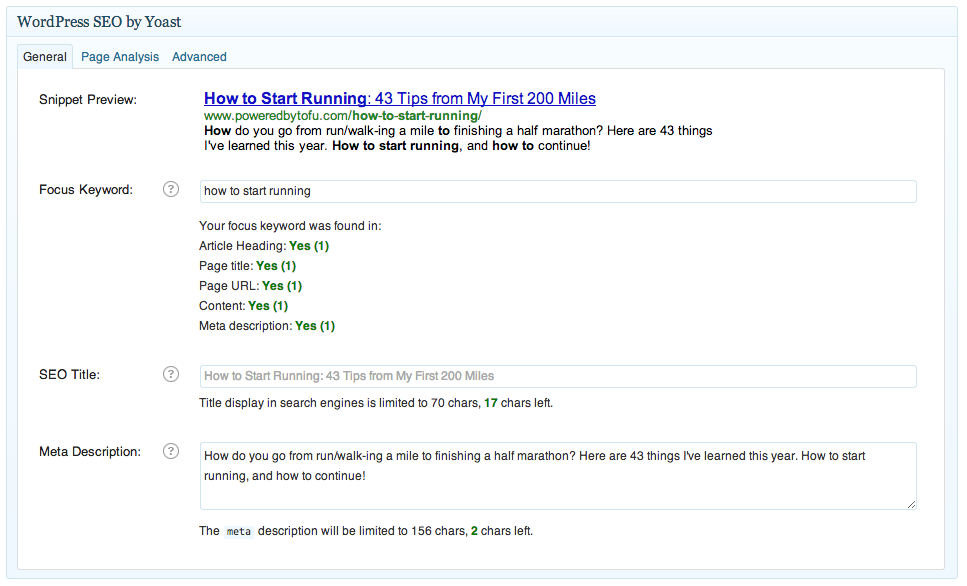
If you’re feeling excited and want to learn more about SEO, Moz has a great beginner’s guide. Otherwise, that’s a wrap and make sure to put your new-found knowledge to the test when you’re writing your next blog post!
What are your tips for writing SEO-friendly headlines? Leave them in the comments!




